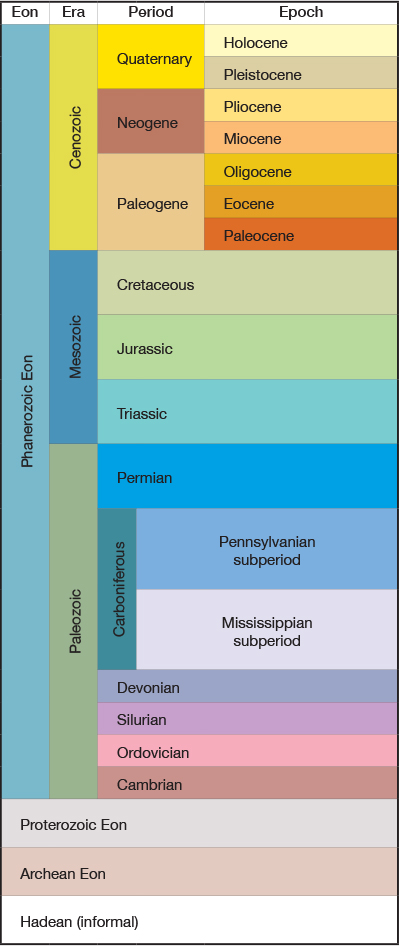Paleozoic Era (541 million years ago to 252 million years ago)

During the Paleozoic Era, which lasted 289 million years, plants and reptiles began moving from the sea to the land. The era has been divided into six periods: Permian, Carboniferous, Devonian, Silurian, Ordovician, and Cambrian. Several times during this era, seas appeared and disappeared in Kansas. Rocks from the last two periods in the era—the Carboniferous and the Permian—can be found at the surface in parts of central and eastern Kansas.
Permian Period (299 million years ago to 252 million years ago)
Cycles of shallow seas, tidal flats, and dry land resulted in deposits of limestone, shale, sandstone, dolomite, gypsum, and chert. Permian rocks are found at the surface in the Flint Hills and south-central Kansas Red Hills. Oil and gas are produced from Permian rocks, and salt left when seas dried is mined underground in central Kansas.
Permian marine animal fossils include mollusks, brachiopods, bryozoans, crinoids, coral, sharks’ teeth, and one-cell fusilinids. Terrestrial leaf and insect fossils have been found. Mass extinction occurred at the end of this period.
Carboniferous Period (359 million years ago to 299 million years ago)
The Carboniferous Period consists of two subperiods: the Pennsylvanian and the Mississippian.
Pennsylvanian subperiod (323 million years ago to 299 million years ago): Cycles of shallow seas, swamps, and river channels resulted in deposits of limestone, sandstone, and shale that are found at the surface in eastern Kansas. In southeast Kansas, rivers and streams flowed into the sea during the Pennsylvanian and deposited sand and other sediments in estuaries and deltas. The resulting thick sandstones form the Chautauqua Hills. Likewise, the shales and sandstones deposited during the early Pennsylvanian subperiod form the Cherokee Lowlands of southeast Kansas and are the second oldest rocks found at the surface in the state. Folding and faulting of rock layers during this period created the Central Kansas Uplift, a mountain ridge now deeply buried. Pennsylvanian marine animal fossils include brachiopods, bryozoans, coral, crinoids, mollusks, and one-cell fusilinids. Terrestrial fossils include plants, amphibians, and early reptiles. Oil, gas, and coal are produced from subsurface Pennsylvanian rock layers.
Mississippian subperiod (359 million years ago to 323 million years ago): Cycles of shallow seas and dry land resulted in deposits of limestone, sandstone, shale, and chert. Found at the surface in far southeastern Kansas, they are the oldest surface rocks. Mississippian marine fossils include crinoids, brachiopods, bryozoans, and mollusks. Oil and gas are produced from subsurface Mississippian rocks.
Devonian Period (419 million years ago to 359 million years ago)
Seas covered Kansas during part of this period. Devonian limestone, shale, dolomite, sandstone, and chert are found in the subsurface. Microscopic fossils and some small marine fossils have been found in rock cores brought up from the subsurface during drilling for oil and gas.
Silurian Period (443 million years ago to 419 million years ago)
Seas covered Kansas during part of this period. Silurian limestone, shale, dolomite, sandstone, and chert are found in the subsurface. Microscopic fossils and some small marine fossils have been found in rock cores brought up from the subsurface during drilling for oil and gas.
Ordovician Period (485 million years ago to 443 million years ago)
Seas covered Kansas during part of this period. Dolomite, limestone, sandstone, shale, and chert from this period are found in the subsurface, and oil and gas are produced from Ordovician rocks. Microscopic fossils and some small marine fossils have been found in rock cores brought up from the subsurface during drilling for oil and gas.
Cambrian Period (541 million years ago to 485 million years ago)
The Cambrian Period in Kansas was marked by erosion early in the period, followed later by shallow seas. Cambrian dolomite, sandstone, limestone, and shale are found in the subsurface. Microscopic fossils and some small marine fossils have been found in rock cores brought up from the subsurface during drilling for oil and gas.